|
Report
from
North America
Suppressed government spending holding back economic growth
Real GDP increased at an annual rate of 2.5% in the first quarter of
2013, according to the first estimate by the US Department of Commerce.
Higher personal consumption, private investment, exports and a stronger
construction market contributed to the higher GDP growth rate. Lower
government spending had a negative effect on GDP growth.
GDP growth could reach 4% in 2013 if public spending would recover,
according to the International Monetary Fund.
The unemployment is slowly edging down. It declined from 7.7% in
February to 7.5% in March, according to the US Bureau of Labor
Statistics. Home builders report that they are not able to hire enough
qualified workers.
Many workers have left home construction when the housing market
collapsed and they work in other industries now. Higher wages in other
industries are also attracting workers away from construction.
Consumers worry that economic recovery may waver
Consumer confidence in the US economy declined from March to April,
according to the Thomson Reuters/University of Michigan consumer
sentiment index.
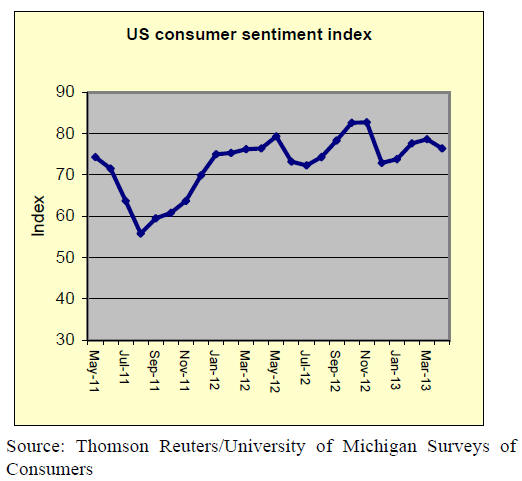
Consumer spending increased because of rising home prices and stock
prices, but consumers worry that the economy will not continue to
expand.
Upper income households in particular have increased spending. The
majority of consumers do not expect the employment situation to improve
this year.
Lack of qualified workers affects builders¡¯ confidence
Builder confidence in newly built single-family homes declined again in
April, according to the National Association of Home Builders.
Home builder confidence has been falling since January, despite
improving demand for new houses.

Finding qualified workers remains a problem in the areas where demand for
new homes is strongest (Arizona, California, Texas, Colorado and
Florida). Many Hispanic immigrants have left the US, especially to
Mexico where the economy is doing very well.
The National Association of Home Builders reported in March that half of
the builders questioned had to delay construction work because of a lack
of labour.
Housing starts exceeded one million in March but fall back in April
US housing starts passed the one-million mark in March for the first
time since 2008. The increase was mainly due to high demand for rental
apartments.
The number of total starts rose to 1.036 million homes in March
(seasonally adjusted annual rate), up by 7% from February.
Multi-family starts increased by 31%, while single-family starts fell by
5%. The share of single-family homes in total starts declined to just
60%.
However, the growth in starts was not sustained in April as starts fell
back to 870,000 units. Analysts did not read too much into this decline
as applications for building permits rose 14.3 percent in April to a
rate of 1.02 million, the highest since June 2008.

The number of building permits issued was 902,000 in March (seasonally
adjusted annual rate), down 4% from February. The number of permits
issued is usually an indicator of future building activity.
Sales of existing homes fell again in March, mainly because of an
insufficient supply of homes on the market. The supply of homes for sale
was at 4.7 months in March (i.e. they would sell out in 4.7 months at
the current sales pace). A 6-month supply is considered a balanced
market between sellers and buyers.
Higher home prices would encourage more home owners to sell, but price
increases remain modest. Home prices increased by 1.9% from February.
The strongest recovery in home prices was in the West (Nevada,
California, Arizona, Idaho and Oregon).
Little change in Canadian housing market
Canada¡¯s housing starts remained stable in March. The Canada Housing and
Mortgage Corporation forecasts lower housing starts in 2013 compared to
the previous year.
The exception is British Columbia where home construction will rise
moderately. A slower housing market is expected to slightly reduce
economic growth in Canada this year.
US non-residential construction market still slow
Spending on non-residential building construction in the US declined by
1.9% in March compared to the previous month (at a seasonally adjusted
rate). Private construction decreased by 1.5% in March, while public
construction fell by 3% due to reduced government spending.
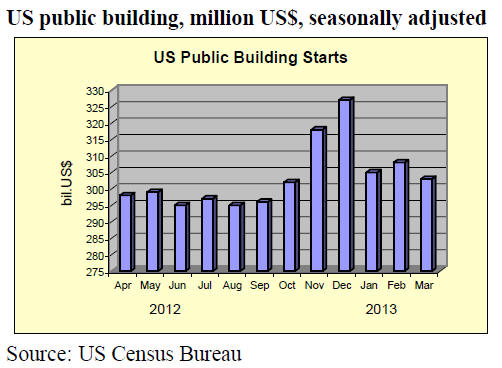
Architecture firms with a commercial/industrial specialization reported
better business conditions in March, according to the Architecture
Billings Index. However, business in the non-residential sector
continues to lag residential construction.
Significantly lower plywood imports from China in March
Plywood imports from China have dropped significantly since the US
Department of Commerce announced in February the preliminary
countervailing duties on Chinese plywood. Imports of other wood products
were largely stable in March, except for a decline in furniture imports.
Hardwood plywood imports fell in March due to significantly lower
imports from China. Total hardwood plywood imports were 198,294 cu.m in
March, down 28% from February. Imports remain higher than in 2012 (+28%
year-to-date).
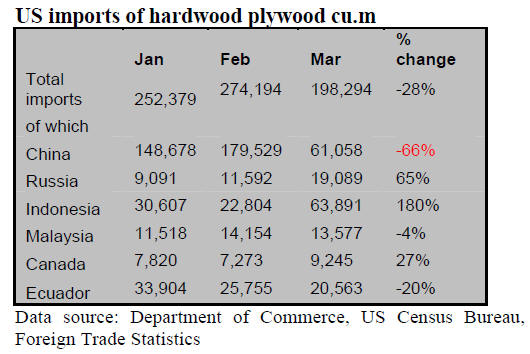
Imports from China fell from 179,529 cu.m in February to 61,058 cu.m in
March (-66%). Imports from Indonesia surpassed imports from China in
March. Indonesian shipments increased to 63,891 cu.m (+104%
year-to-date).
Imports from Malaysia were 13,577 cu.m in March (+67% year-to-date).
Shipments from Ecuador were 20,563 cu.m (+470% year-to-date). Ecuador
has been the third-largest supplier of hardwood plywood so far in 2013,
after China and Indonesia.
Hardwood moulding imports decline
Hardwood moulding imports declined further in March to $12.1 million
(-15% year-to-date). Imports from Brazil remained stable from February
at $2.8 million, (-19% year-to-date).
Hardwood moulding imports from China were worth $3.8 million (-23%
year-to-date). Imports from all other major suppliers also declined in
March.
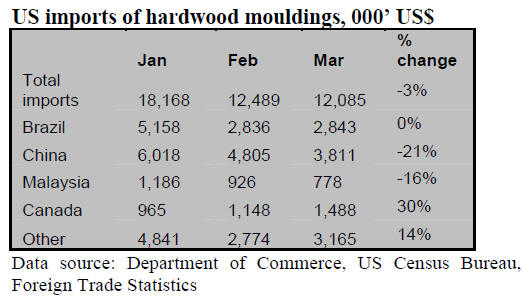
Imports of hardwood flooring from China nose dive
Hardwood flooring imports declined further to $2.1 million in March.
Indonesia¡¯s shipments more than doubled to $1.2 million in March (+326%
year-to-date).
Malaysian hardwood flooring exports were worth $0.3 million in March
(-40% year-to-date). Imports from China decreased to $0.1 million in
March (+59% year-to-date), but it remains the second-largest supplier to
the US market in 2013 after Indonesia.
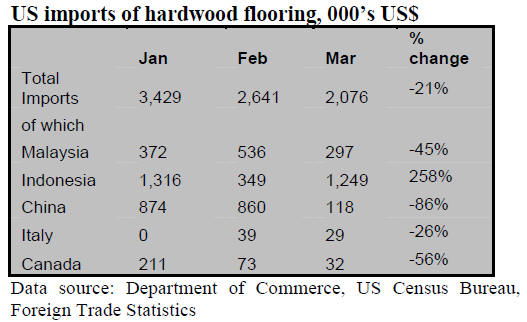
US imports of assembled flooring panels declined to $7.3 million in March,
and they are only 3% above year-to-date imports in 2012. Imports from
China fell to $3.3 million (-5% year-to-date).
Canada¡¯s shipments grew to $2.3 million (+15% year-to-date).
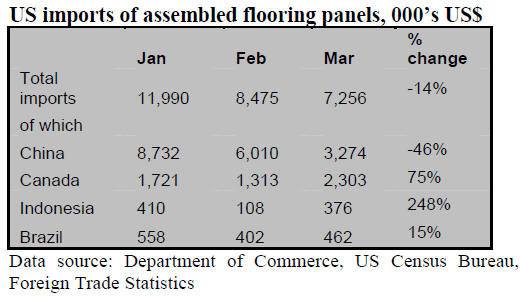
Wooden furniture imports growing despite March declines
US imports of wooden furniture fell below $1 billion for the first time
in the last 12 months. March imports were worth $813.9 billion, down 21%
from the previous month. Year-to-date imports are still 6% higher than
in 2012.
China¡¯s furniture shipments to the US fell to $316.6 million (+8%
year-to-date). Imports from Vietnam declined to $121.0 million in March
(+11% year-to-date).
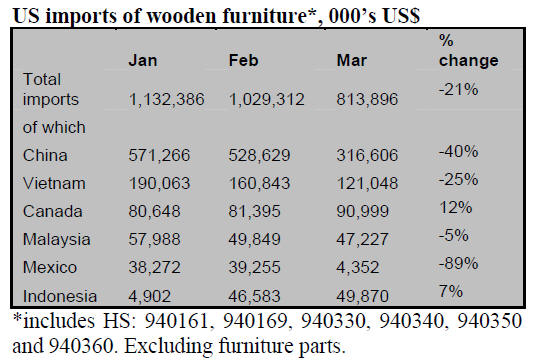
Many US SMEs exit kitchen and bathroom cabinet manufacturing sector
Sales of cabinets for kitchens and bathrooms were severely affected
by the economic recession in the US. The low demand from new
construction and remodeling of existing homes continues to have an
effect on the industry today.
In the last five years industry concentration has increased because many
smaller companies had to close their business, according to a recently
released report by IBISWorld (Cabinet and Vanity Manufacturing in the
US).
However, the majority of US cabinet manufacturers remain small
companies. The four largest US manufacturers account for less than 25%
of sales.
Cabinet sales started to recover in 2011. Freedonia predicts cabinet
demand to grow by an average 8.2% per year to $15.3 billion in 2016
(Cabinets: US Industry Study with Forecasts for 2016 & 2021).
New housing is expected to be the strongest driver of demand, but the
renovation of kitchens and bathrooms remains an important market.
The trend to larger kitchens and larger cabinets will support demand,
according to Freedonia. The bathroom cabinet market is forecast to grow
6.5% per year to reach US$1.8 billion in 2016. More homes have multiple
bathrooms, which has a positive effect on cabinet sales.
Cabinet demand in non-residential applications is expected to grow 6.5%
per year to $2.8 billion in 2016. Growth in the construction of offices,
retail stores and hotels will support demand for cabinets.
Preliminary anti-dumping duties for plywood imports from China
The US Department of Commerce announced on April 30 the preliminary
anti-dumping duties on decorative plywood imports from China.
These duties were to come into effect on July 17 but, because two of the
affected companies requested the postponement of the deadline the entry
into force was delayed to allow for further investigation.
Those investigations have been concluded and the duties will come into
effect in July. The new duties will be added to the existing preliminary
countervailing duties, which range from 0.22% to 27.16%.
Two companies will not pay any anti-dumping duties (Linyi San Fortune
Wood Co. and Jiangyang Group).
Over 100 companies were assigned a preliminary anti-dumping duty of
22.14%. All other producers will pay the China-wide duty of 63.96%.
Plywood from China has an estimated 30% market share in the US. All
hardwood and decorative plywood is subject to the investigation and
duties, including plywood with face and back veneer made from softwoods
or bamboo.
Structural plywood and shaped plywood are excluded from the
investigation.
¡¡
|